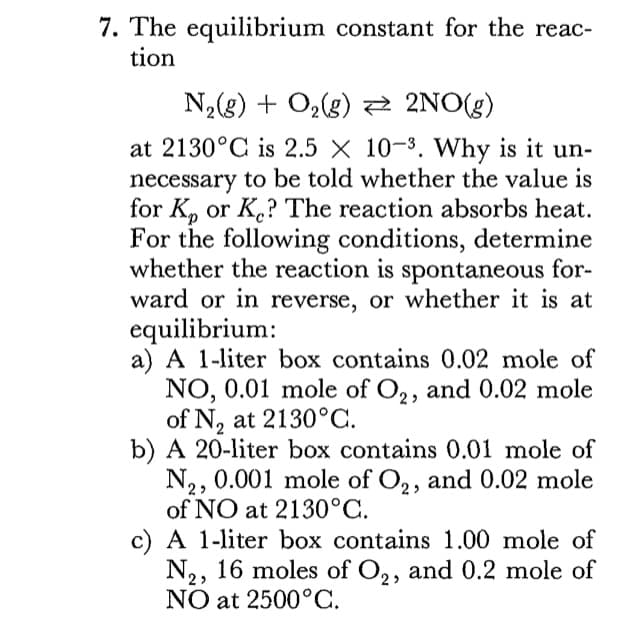7. The equilibrium constant for the reac- tion N2(8) + O2(g) 2NO(g) at 2130°C is 2.5 × 10-3. Why is it un- necessary to be told whether the value is for K, or K.? The reaction absorbs heat. For the following conditions, determine whether the reaction is spontaneous for- ward or in reverse, or whether it is at equilibrium: a) A 1-liter box contains 0.02 mole of NO, 0.01 mole of O2, and 0.02 mole of N, at 2130°C. b) A 20-liter box contains 0.01 mole of N,, 0.001 mole of O,, and 0.02 mole of NO at 2130°C. c) A 1-liter box contains 1.00 mole of N2, 16 moles of O,, and 0.2 mole of NO at 2500°C.
7. The equilibrium constant for the reac- tion N2(8) + O2(g) 2NO(g) at 2130°C is 2.5 × 10-3. Why is it un- necessary to be told whether the value is for K, or K.? The reaction absorbs heat. For the following conditions, determine whether the reaction is spontaneous for- ward or in reverse, or whether it is at equilibrium: a) A 1-liter box contains 0.02 mole of NO, 0.01 mole of O2, and 0.02 mole of N, at 2130°C. b) A 20-liter box contains 0.01 mole of N,, 0.001 mole of O,, and 0.02 mole of NO at 2130°C. c) A 1-liter box contains 1.00 mole of N2, 16 moles of O,, and 0.2 mole of NO at 2500°C.
Chemistry by OpenStax (2015-05-04)
1st Edition
ISBN:9781938168390
Author:Klaus Theopold, Richard H Langley, Paul Flowers, William R. Robinson, Mark Blaser
Publisher:Klaus Theopold, Richard H Langley, Paul Flowers, William R. Robinson, Mark Blaser
Chapter16: Thermodynamics
Section: Chapter Questions
Problem 37E: Consider the decomposition of red mercury(II) oxide under standard state conditions.....
Related questions
Question

Transcribed Image Text:7. The equilibrium constant for the reac-
tion
N,(g) + Oz(g) 2 2NO(g)
at 2130°C is 2.5 X 10-3. Why is it un-
necessary to be told whether the value is
for K, or K.? The reaction absorbs heat.
For the following conditions, determine
whether the reaction is spontaneous for-
ward or in reverse, or whether it is at
equilibrium:
a) A 1-liter box contains 0.02 mole of
NO, 0.01 mole of O,, and 0.02 mole
of N, at 2130°C.
b) A 20-liter box contains 0.01 mole of
N,, 0.001 mole of O,, and 0.02 mole
of NO at 2130°C.
c) A 1-liter box contains 1.00 mole of
N2, 16 moles of O,, and 0.2 mole of
NO at 2500°C.
Expert Solution
This question has been solved!
Explore an expertly crafted, step-by-step solution for a thorough understanding of key concepts.
Step by step
Solved in 2 steps with 2 images

Knowledge Booster
Learn more about
Need a deep-dive on the concept behind this application? Look no further. Learn more about this topic, chemistry and related others by exploring similar questions and additional content below.Recommended textbooks for you

Chemistry by OpenStax (2015-05-04)
Chemistry
ISBN:
9781938168390
Author:
Klaus Theopold, Richard H Langley, Paul Flowers, William R. Robinson, Mark Blaser
Publisher:
OpenStax


Chemistry
Chemistry
ISBN:
9781305957404
Author:
Steven S. Zumdahl, Susan A. Zumdahl, Donald J. DeCoste
Publisher:
Cengage Learning

Chemistry by OpenStax (2015-05-04)
Chemistry
ISBN:
9781938168390
Author:
Klaus Theopold, Richard H Langley, Paul Flowers, William R. Robinson, Mark Blaser
Publisher:
OpenStax


Chemistry
Chemistry
ISBN:
9781305957404
Author:
Steven S. Zumdahl, Susan A. Zumdahl, Donald J. DeCoste
Publisher:
Cengage Learning

Chemistry: An Atoms First Approach
Chemistry
ISBN:
9781305079243
Author:
Steven S. Zumdahl, Susan A. Zumdahl
Publisher:
Cengage Learning

Chemistry: Principles and Reactions
Chemistry
ISBN:
9781305079373
Author:
William L. Masterton, Cecile N. Hurley
Publisher:
Cengage Learning

Chemistry & Chemical Reactivity
Chemistry
ISBN:
9781133949640
Author:
John C. Kotz, Paul M. Treichel, John Townsend, David Treichel
Publisher:
Cengage Learning